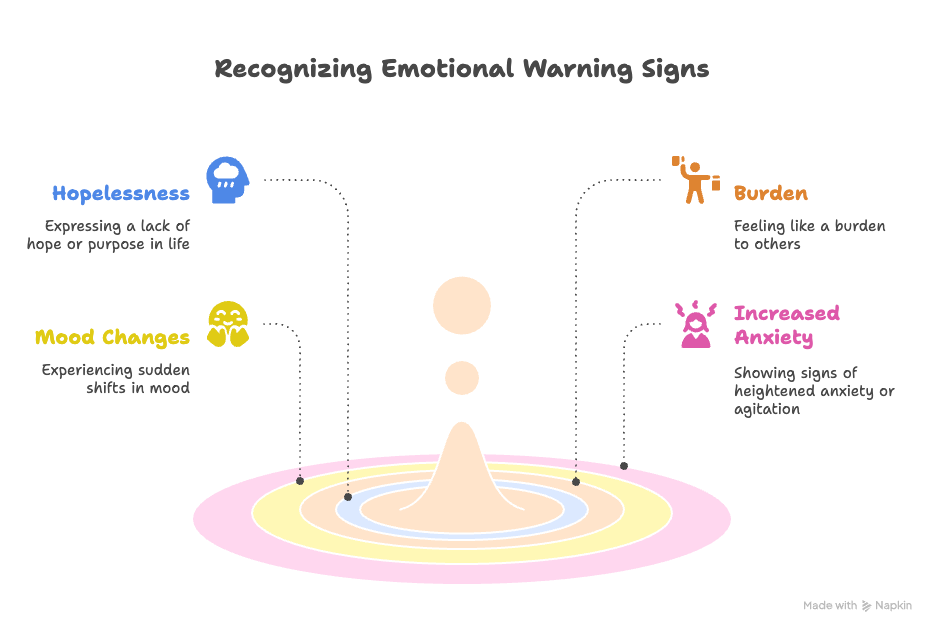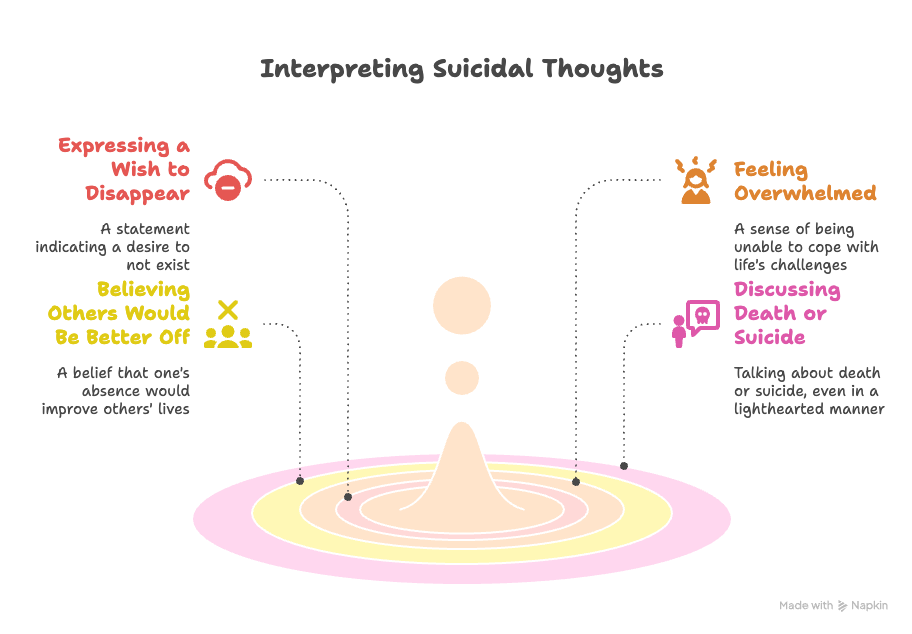If you've ever had thoughts of suicide, or if someone you care about has shared such feelings with you, know that you're not alone—and that there is hope. Suicidal thoughts are often a sign that someone is experiencing overwhelming emotional pain and can't see other ways to make it stop. The good news is that with proper support, resources, and time, people can and do recover from suicidal crises.
This guide offers practical tools and insights for both those experiencing suicidal thoughts and those who want to help someone they care about. Remember: this information supplements but never replaces professional mental health care.
Understanding Suicidal Thoughts
What Suicidal Thoughts Really Mean
Suicidal thoughts don't necessarily mean someone wants to die—they often mean someone wants their emotional pain to end. These thoughts can range from fleeting wishes to escape difficulties to more detailed plans and strategies. All should be taken seriously, but understanding this spectrum helps us respond appropriately.
Common Warning Signs
Emotional signs:
Talking about feeling hopeless, trapped, or having no purpose
Expressing feelings of being a burden to others
Sudden mood changes or seeming suddenly calm after depression
Increased anxiety, agitation, or rage
Behavioral signs:
Withdrawing from friends, family, and activities
Giving away possessions or saying goodbye
Increased alcohol or drug use
Dramatic changes in sleep or eating patterns
Taking risks that could lead to death
Verbal signs:
"I wish I weren't here."
"I can't do this anymore."
"You'd be better off without me."
Talking about death or suicide, even jokingly
Practical Tools for Those Experiencing Suicidal Thoughts
The Safety Planning Process
Create a written safety plan that includes:
Your personal warning signs - List thoughts, feelings, or situations that might lead to a crisis
Internal coping strategies - Activities you can do alone (listening to music, taking a shower, going for a walk)
Social contacts for distraction - Friends or family who can provide distraction without discussing the crisis
Support contacts - People you can talk to about your feelings
Professional resources - Therapist's number, crisis hotline numbers, emergency contacts
Environmental safety - Remove or secure means of self-harm
Immediate Coping Strategies
The STOP technique:
Stop what you're doing
Take three deep breaths
Observe your surroundings and emotions without judgment
Proceed with a planned coping strategy
Grounding exercises:
Do an imaginary body scan, from head to toe, and notice any sensations and feelings
Hold ice cubes in your hands
Focus on the physical sensation of your feet on the ground
Delay and distraction:
Commit to waiting 24 hours before acting on suicidal thoughts
Call a friend, watch a movie, or engage in a hobby
Sometimes the intensity of feelings will decrease with time
Building Your Support Network
Identify at least 2-3 people you can contact during difficult times
Let trusted friends or family know about your struggles
Consider joining a support group
Maintain regular contact with a mental health professional
How to Help Someone Who May Be Suicidal
Having the Conversation
Do:
Ask directly: "Are you thinking about suicide?" or "Are you thinking about hurting yourself?"
Listen without judgment
Take their feelings seriously
Stay calm and show you care
Help them connect with professional resources
Don't:
Avoid the topic or change the subject
Promise to keep their suicidal thoughts secret
Leave them alone if they're in immediate danger
Try to argue them out of their feelings
Say things like "you have so much to live for" or "think about your family"
Creating a Supportive Environment
Remove potential means of self-harm from their environment
Help them follow through with professional appointments
Check in regularly, but respect boundaries
Learn about mental health conditions and treatment options
Take care of your own mental health, too
When to Seek Immediate Help
Call 911 or go to the emergency room if someone:
Has a specific suicide plan
Has access to the means to carry out the plan
Says they're going to kill themselves
Has severely impaired judgment due to psychosis, drugs, or alcohol
Professional Resources and Crisis Support
National Crisis Resources
988 Suicide & Crisis Lifeline
Call or text 988
Available 24/7, free and confidential
Chat available at 988lifeline.org
Crisis Text Line
Text HOME to 741741
Free, 24/7 crisis support via text
National Suicide Prevention Lifeline
Call 1-800-273-8255
Available 24/7
Finding Long-term Support
Contact your primary care doctor for referrals
Use your insurance company's provider directory
Check with local community mental health centers
Consider online therapy platforms if in-person isn't accessible
Look into support groups through NAMI (National Alliance on Mental Illness)
Building Resilience and Hope
Developing Coping Skills
Mindfulness practices:
Daily meditation, even for 5-10 minutes
Mindful breathing exercises
Body scan relaxation techniques
Physical wellness:
Regular exercise, even just walking
Adequate sleep (7-9 hours for most adults)
Nutritious eating patterns
Limiting alcohol and avoiding drugs
Social connection:
Maintain relationships even when it's difficult
Volunteer or help others when possible
Join clubs or groups aligned with your interests
Consider adopting a pet for companionship
Finding Meaning and Purpose
Identify activities that give you a sense of accomplishment
Set small, achievable goals
Connect with causes you care about
Explore creative outlets like art, music, or writing
Practice gratitude by noting positive moments, however small
Recovery and Moving Forward
Here's something important: recovery from suicidal thoughts is absolutely possible. I know it might not feel that way right now, but so many people who've been where you are have gone on to live fulfilling, meaningful lives. It usually takes time and professional support, but it happens.
Recovery often includes things like:
Working consistently with a mental health professional
Building strong relationships with people who support you
Learning coping strategies that actually work for you
Getting proper treatment for any underlying mental health conditions
Making lifestyle changes that support your overall well-being
Just know that recovery isn't a straight line. There will probably be setbacks, and that's completely normal. What matters is that you keep reaching out for support and using the tools available to you.
Final Thoughts
Whether you're trying to help someone else or working through your own struggles, please remember that asking for help is actually incredibly brave. Suicidal thoughts are symptoms of treatable conditions, and with the proper support, people really do get better.
If you're in crisis right now, please reach out to someone. Call a crisis line, text a friend, or go to the emergency room. Your life matters, and some people want to help you get through this.
Sometimes it's hard to believe that things can get better when you're in the middle of so much pain. But they can, and they do. You're worth fighting for, even when you don't feel like it.
This article is for educational purposes and doesn't replace professional mental health treatment. If you or someone you know is in immediate danger, please call 911 or go to your nearest emergency room.













